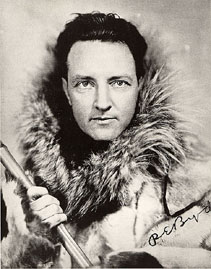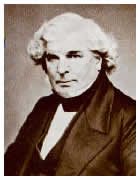
Roald Amundsen (1872-1928) was a Norwegian polar explorer who was the first person to fly over the North Pole in a dirigible (May 11-13, 1926) and was the first person to reach the South Pole. Amundsen and his small expedition reached the South Pole on December 14, 1911, traveling by dog sled. Amundsen was also the first person to sail around the world through the Northeast and Northwest passages, from the Atlantic to the Pacific (in 1905). He was the first person to reach both the North and South Poles. Amundsen died in a plane crash attempting to rescue his friend, the Italian explorer Umberto Nobile who was lost in an airship.

Admiral Richard Evelyn Byrd (1888-1957) was an Arctic and Antarctic explorer, pioneering aviator, and US Naval Officer. On May 9, 1926, Byrd (the navigator) and Floyd Bennett (the pilot) made what may have been the first airplane trip over the North Pole, in a 15 1/2 hour flight; they flew from King's Bay, Spitsbergen, Norway, to the North Pole and back again. There is a dispute as to whether or not they actually reached the pole. He also made many trips to Antarctica.

FIENNES, RANULPH
Sir Ranulph Twistleton-Wykeham-Fiennes (March 7, 1944- ) is an English explorer and author who has led over 30 expeditions to the North and South Poles, the desert, the Nile, and many other remote places. In 1982, Fiennes led the first polar circumnavigation of the Earth. In 1992, Fiennes and others found the legendary Lost City of Ubar in the desert of Oman. In 1993, Fiennes and Dr. Mike Stroud made the first unsupported walk across the continent of Antarctica, each man dragging a 500-pound sledge.
Fiennes holds many world exploration records. The Guiness Book of Records described Fiennes as "the world's greatest living explorer."
HILLARY, EDMUND
Sir Edmund Percival Hillary (1919 - ) is a mountain climber, Antarctic explorer, and beekeeper from New Zealand. Hillary and the Nepalese mountaineer Tenzing Norgay, were the first people to reach the top of Mount Everest on May 29, 1953. Mount Everest is the highest mountain in the world (29,028 feet = 8,848 m). Hillary went on many other adventures, including other expeditions than to Mt. Everest, reaching the South Pole by tractor on Jan. 4, 1958, and climbing Mt. Herschel (10,941 feet = 3,335 m) in 1967 (his was the first expedition to climb it), and leading the first expedition to jet boat up the Ganges River to find its source. Hillary wrote many books about his adventures, including High Adventure (1955), The Crossing of Antarctica (1958; with Fuchs), and No Latitude for Error (1961), and Nothing Venture, Nothing Win (1975)

Douglas Mawson (1882 - 1958) was an Australian geologist and explorer. Mawson was a member of the British Antarctic Expedition (1907-1909) which was led by Ernest Shackleton. On a three-man sledge trip, Mawson, A.F. Mackay, and Edgeworth David traveled to the magnetic South Pole. Mawson was among the first to climb Antarctica's Mount Erebus. Mawson also went on the scientific Australasian Antarctic Expedition (1911-1914). During this expedition, Mawson went on an ill-fated trip in which only Mawson survived, walking 100 miles (160 km) alone, hauling his geological specimens on a sled. His book "The Home of the Blizzard," is an account of this journey. Later, Mawson led the British, Australian, New Zealand Antarctic Research Expedition (BANZARE) of 1929-31, mapping the coastline of Antarctic and discovering Mac. Robertson land and Princess Elizabeth Land (which later became the Australian Antarctic Territory). Early in his career, in 1906, Mawson identified and named the radioactive mineral Davidite (named for T. W. Edgeworth David). Mawson appears on an Australian stamp and $100 bill.

ROSS, JAMES CLARK
Sir James Clark Ross (1800 - 1862) was a British explorer and naval officer who went on missions to both the Arctic and the continent of Antarctica, doing magnetic surveys.
The Arctic: Ross went on Arctic expeditions with Sir William E. Parry from 1819 to 1827. Ross and his uncle, Sir John Ross, located the north magnetic pole on Boothia Peninsula (in northern Canada, north of King William Island) on May 31, - June 1, 1831.
Antarctica: James Ross led an Antarctic expedition (1839-43), commanding the "Erebus" while his friend Francis Crozier commanded the "Terror." Ross charted much of the coastline and in 1841 discovered the Ross Sea, and the Victoria Barrier, which was later renamed the Ross Ice Shelf.
SCOTT, ROBERT F.
Robert Falcon Scott (June 6, 1868 - March 29, 1912) was a British naval officer and Antarctic explorer. Scott led two expeditions to the South Pole, and died on the disastrous second trip, along with his crew. His expedition was the second to reach the South Pole (1910-1912); Roald Amundsen led the first.
SHACKLETON, ERNEST HENRY
Sir Ernest Henry Shackleton (1872-1922) was a British explorer (born in Ireland) and member of the Royal Naval Reserve. Shackleton was involved in many expeditions attempting to reach the South Pole.
WEDDELL, JAMES
James Weddell (1787 -1834) was an English explorer, naturalist, geographer, and sealer who sailed on three expeditions to the Antarctic (in the years 1820-21, 1821-22 and 1822-23). Captain Weddell sailed on the brig "Jane." On these sealing/scientific expeditions, Weddell discovered the Weddell Sea (near the South Pole) and the Weddell Seal, Leptonychotes weddelli in 1823. Captain Weddell also set an 80-year record for the farthest southern latitude reached (74°15'S, set February 20, 1823). Weddell wrote of his adventures in the book, "A Voyage Towards the South Pole in the Years 1822-24" (published in 1825). Weddell died in poverty at the age of 47.


No comments:
Post a Comment